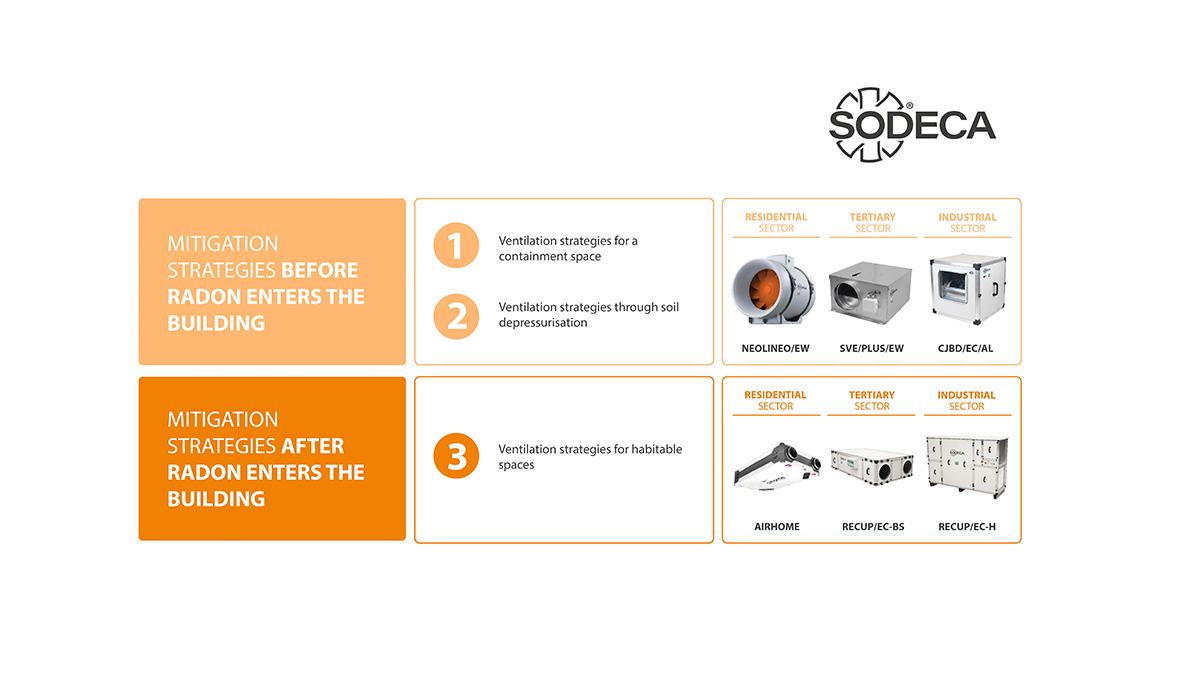Radon is a naturally occurring radioactive contaminant that originates from the decay of uranium. This decay results in the emission of high-energy alpha particles, which can damage DNA, leading to mutations and tumour formation. This carcinogenic element tends to accumulate in underground or low-lying spaces and can enter buildings through infiltration from granitic soils, and to a lesser extent, via water and some construction materials.
One of the greatest risks posed by radon gas is that it is present in everyday environments, from homes to workplaces. In fact, a study conducted by Spanish researchers, published at the end of 2023, concluded that in radon-prone areas, contamination levels in schools, offices, or public buildings are comparable to, or even higher than, those measured in more heavily regulated sectors, such as underground mines or thermal facilities.

It is therefore not surprising that the World Health Organisation (WHO) estimates that up to 14% of lung cancer cases worldwide are attributable to radon exposure, making it the second leading cause after smoking. Moreover, the WHO warns that a smoker's risk of developing lung cancer increases tenfold when also exposed to radon.
Ventilation Solutions
Given these statistics, the question arises: how can we mitigate radon gas to neutralise its impact on human health? The fact is, there are various protective solutions against radon, generally focused on its presence in the ground. These solutions primarily aim to reduce people's exposure to radon within buildings and can be broadly categorised into isolation or ventilation solutions. Isolation solutions involve protective barriers that improve the airtightness of the building's envelope, which is in contact with the ground.
However, in existing buildings, not newly constructed, such isolation solutions are often limited by the presence of pre-existing structural elements, as well as the scope of the intervention and available financial resources. Therefore, ventilation solutions often emerge as the most viable option.

In this regard, SODECA offers a range of ventilation solutions that vary depending on the strategy to be implemented, whether the aim is to mitigate radon before or after it enters the building. If the goal is to prevent its infiltration, one option is to ventilate a containment space located between the ground and the interior space to be protected. Alternatively, the soil can be depressurised using a mechanical extractor. In both cases, it is essential to use high-efficiency equipment with EC motors, as the ventilation system must operate continuously.
Ventilation of habitable spaces
However, these ventilation solutions can be more challenging to implement if radon is detected in an already built structure, as the containment space may not exist, and depressurisation may require significant additional works. Ventilating the interior space itself, on the other hand, is a viable and effective solution, both for new buildings and for refurbishments if radon is detected later.
This solution aims to reduce radon concentrations inside habitable spaces. To achieve this, air renewals within the building are increased through the use of mechanical ventilation systems. These systems help dilute the accumulation of gaseous compounds, such as radon, by introducing clean air and extracting the contaminated air.

This process, however, can result in considerable energy expenditure, as expelling the contaminated air can also lead to the loss of temperature achieved by heating or cooling systems. To avoid this, ventilation solutions for habitable spaces should be designed with heat recovery units, which are capable of filtering and renewing the indoor air while recovering part of the energy used for heating and cooling.
This solution aims to reduce radon concentrations inside habitable spaces. To achieve this, air renewals within the building are increased through the use of mechanical ventilation systems. These systems help dilute the accumulation of gaseous compounds, such as radon, by introducing clean air and extracting the contaminated air.
In this regard, SODECA offers ventilation solutions with heat recovery for all types of buildings, from residential to industrial. For homes, SODECA's AIRHOME system is a dual-flow ventilation solution with a heat exchanger that renews indoor air by extracting it from moist areas, such as kitchens and bathrooms, and transferring the heat to the fresh air entering the dry areas of the home. This ensures optimal air quality, thanks to the AIRHOME’s filtration system, while preventing energy losses. In this way, air renewals rates can be increased, and radon presence in the home can be mitigated, without compromising energy efficiency.
